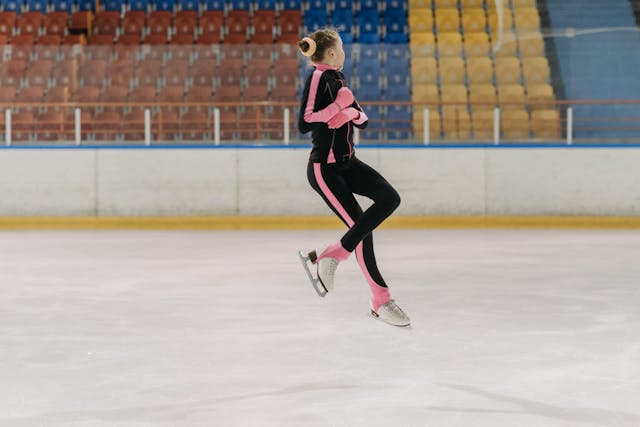
Is a quintuple jump in figure skating possible? Technically, a quintuple jump in figure skating would be possible. It all comes down to the speed of the jump and the conservation of angular momentum.
The quadruple jump is where figure skaters take off from the ice, do four complete rotations, and then land back on the ice to continue skating. Up until one was successfully landed by Canadian Kurt Browning, the quadruple jump was thought to be impossible. Now, it is routine. In 2022, American Ilia Malinin landed a quadruple Axel. An Axel jump is where you land backwards, meaning an extra half rotation. That is only 0.5 rotations away from the quintuple. So, of course, people are now wondering when the first quintuple jump will be landed. A quintuple would mean five complete rotations in the air before landing successfully. One thing to consider is that just because it hasn’t been completed doesn’t mean it isn’t possible. The risk of injury to a skater would be high, and skaters lose points for falling, so there would be little benefit in trying it in a competition.
There are two things that are needed to make a quintuple jump possible. The first is the height they can jump, and the second is how quickly the skater can spin. If they can jump high but can’t spin, they won’t get in the five rotations, and if they can spin very quickly but can’t jump high enough, they won’t have enough time to complete the rotations.
Most ice skaters can jump to roughly the same height. They all have strong legs, but they need to be light and fast, so they cannot build up too much bulky muscle. That means the ability to perform more rotations in the air comes down to having more leg strength without extra weight. Skaters travel at roughly 25 km/h when they go into their jumps, and that gives them about 0.6 to 0.7 seconds in the air. Going faster won’t increase their airtime; it will just mean they land further along the ice. The only way to increase their airtime is to jump higher. Technology could help to increase the airtime of figure skaters. Clothing that lowered wind resistance, such as that worn by speed skaters, for example, could lower air resistance enough to give them a fraction more airtime. Skates with slight suspension could add to the jumping height, although that would be illegal. However, this would be a trade-off because anything that improved jump height might make other figure skating moves more difficult. It will probably come down to one person who just happens to have more muscle elasticity without extra muscle mass.
The second thing is how quickly the skater can spin. The speed with which a figure skater spins comes down to the conservation of angular momentum. The principle of momentum conservation comes from Newton’s laws of motion. An object in motion will remain in motion unless it is acted upon by an outside force. On Earth, this is usually friction, and it is why the Voyager space probes are still going in a straight line. The conservation of angular momentum is similar. A spinning object will continue spinning so long as there is no external torque applied to it. The speed at which something spins is a combination of its rotational inertia, which is how its mass is spread out, and its rotational velocity. If you increase the rotational inertia by moving the mass further out from the center of gravity, the rotational velocity will decrease. If you decrease the rotational inertia by bringing the mass closer to the center of gravity, you will increase the rotational velocity. When figure skaters jump, they use their push off to start to rotate, and they bring their arms in as close to their bodies as possible to increase their rotational velocity as much as they can. For a skater to make five rotations, they are going to need to spin even faster. At some point, it becomes difficult because of the G force and because of the weight on the arms. At that speed, the arms are being pulled out, and it takes a tremendous amount of strength to keep them tucked into the body. Experimenters gave skaters hand weights, which increased their rotational velocity when they pulled them in tight, but it was very hard for the skaters to stop them from being pulled out again. For someone to make five rotations in less than a second, they are going to need to be small, but ridiculously strong.
Are we going to see a quintuple jump in Olympic events in future years? It is possible, but unlikely. The speed at which a skater would have to rotate would be verging on the dangerous. There doesn’t seem to be enough of a payoff to make it likely. And this is what I learned today.
Sources
https://en.wikipedia.org/wiki/Angular_momentum
https://www.exploratorium.edu/snacks/momentum-machine
https://en.wikipedia.org/wiki/Quadruple_jump
https://en.wikipedia.org/wiki/Axel_jump
https://slate.com/culture/2022/02/figure-skating-quintuple-jumps-quints-possible-doable-physics.html
https://acsm.org/the-science-of-figure-skating-jumps
https://physics.stackexchange.com/questions/505636/what-determines-the-top-speed-in-ice-skating
Photo by Pavel Danilyuk: https://www.pexels.com/photo/an-ice-skater-flip-jumping-in-the-air-6539380/
